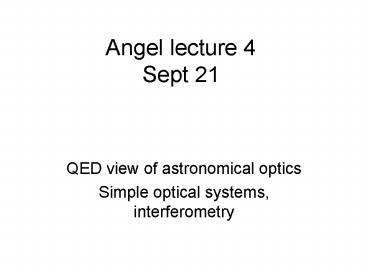Angel lecture 4 Sept 21 - PowerPoint PPT Presentation
1 / 25
Title:
Angel lecture 4 Sept 21
Description:
Ideal diffraction limited images by QED. GMT same FWHM as 24.4 m filled circle. 24.4 m Airy GMT ... In thermal infrared, beams or baffles glow much brighter than sky ... – PowerPoint PPT presentation
Number of Views:74
Avg rating:3.0/5.0
Title: Angel lecture 4 Sept 21
1
Angel lecture 4Sept 21
- QED view of astronomical optics
- Simple optical systems, interferometry
2
Ideal diffraction limited images by QED GMT
same FWHM as 24.4 m filled circle24.4 m Airy
GMT
3
Starting point
- Per homework
- star photon detection probability for circular
aperture parabolic telescope - classic Airy diffraction pattern
- FWHM of pattern in focal plane corresponds to
angle l/D on sky HST resolution
4
Example of more complex telescope aperture
- Giant Magellan Telescope (GMT)
- Next generation ground telescope
- Being designed by Arizona, Carnegie
Observatories, CfA, MIT, Michigan, Texas - Aperture synthesized from 7 X 8.4 m mirrors
5
(No Transcript)
6
(No Transcript)
7
How do you get paths across 25 m aperture
accurate enough for diffraction limit?
- Need to control whole surface to fit paraboloid
to accuracy ltlt 1.6 mm wavelength - Steel structure supporting primary segments bends
much more than this in wind gusts - Hard to servo position of 18 ton segments to 100
nm - SOLUTION
- Use fact that paths reflect also off secondary
mirror before coming to focus - Make correction at much smaller, more agile
secondary - Secondary segments are 1.1 m diameter
8
(No Transcript)
9
View of secondary from infrared instrument
- Secondary segments seen against sky
- In thermal infrared, beams or baffles glow much
brighter than sky - Need to eliminat background photons from sky that
just add noise at detector.
10
Exoplanet detection with GMT
- take advantage of very high angular resolution
- l/D 0.014 arcsec at l1.65 mm
- For reference, 1 AU at 10 pc 0.100 arcsec
- But how do we get very high contrast?
- Jupiter at 1 AU is 10-8 of sun
11
(No Transcript)
12
Deform shape of secondary to change point spread
function (PSF)
- Waves across secondary will place added light at
spot in halo - Translation of wave across aperture changes phase
of spot - Match spot amplitude and angle to null local psf
pixel - superpose waves to match in detail each pixel of
the diffraction pattern
13
(No Transcript)
14
(No Transcript)
15
Speckles induced in a 1.6 micron real star image
from the MMT AO system
3 wave ripple induced by deformable secondary
across 6.5 m diameter Amplitude about 200
nm Little vectors biased in one direction, dont
curl up
16
suppression of 180 degrees of diffraction pattern
with shape deformable secondary (Codona)
17
(No Transcript)
18
(No Transcript)
19
Atmospheric wavefront aberration must also be
corrected dynamical deformation of secondary-
adaptive optics
- Thermal variations in atmosphere cause
differences in path length across primary mirror - Refractive index of STP air n 1.0003
- Pressure constant, so from gas law
dT/Tdr/r - dn/n n so dn10-6/K
- Representative atmospheric case
- boundary between air streams with DT 1 K and 1 m
rms amplitude roughness on 1 m scale - Yields 1mm rms path length variations on 1 m
scale - Actual boundary has variations on all scales
given by Kolmogorov turbulence amplitude as
x5/6
20
path variations taken up by deforming shape of
secondary
- Done at MMT, LBT and GMT
- Typical turbulence is fixed screen moving by at
wind speed like an invisible cloud carried by
wind - Speed 20 km/sec
- For 1 m turbulence time scale is 50 msec
- In practice servo needs 1 msec updates to follow
21
(No Transcript)
22
(No Transcript)
23
How can we actually know the arrow direction for
a detected photon?
- We cant
- But we can if the aberration remains fixed, while
a number of photons are detected - Method of interferometry
24
(No Transcript)
25
Numerical models of suppression with deformable
secondary

